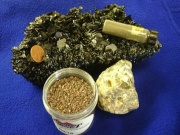Abrasive
Description
Hard, fine particles used to polish metals, stone, wood, glass, and other materials. Naturally occurring materials used as abrasives include Diamond, Emery, Corundum, Sand, Garnet, Quartz, Pumice, diatomite, Kaolin, Fuller's earth, Talc, Chalk, and cuttlefish bone. Manufactured materials used as abrasives include Silicon carbide, Aluminum oxide, Zirconium oxide, Titanium dioxide, green rouge (Chromic oxide), Stannic oxide, cerium oxide, Glass, Boron carbide, boron nitride, and Synthetic diamond. Abrasives are sold as powders, slurries, and as abrasive cloths, papers, and wheels. They are characterized by hardness and particle size. Their hardness can be measured on the Mohs' scale in which the diamond is rated as a 10. Mild abrasives, such as chalk and talc, have a hardness of 1-3 Mohs. Diamond and silicon carbide are hard abrasives. Particle size depends on the mesh of the sieves used for separation, i.e. a 600 grit abrasive contains particles 8 micrometers and smaller.
Synonyms and Related Terms
diamond; emery; corundum; sand; garnet; quartz; pumice; diatomite; kaolin; fuller's earth; talc; chalk; cuttlefish bone; silicon carbide; aluminum oxide; zirconium oxide; titanium dioxide; green rouge; chromic oxide; tin oxide; cerium oxide; glass; boron carbide; boron nitride; steel wool; abrasive paper; lubrisil, micromesh; abrasive powder; crocus powder; jewelers rouge; rottenstone; tripoli powder; whiting; Schleifmittel (Deut.); abrasif (Fr.);
Comparisons
| Compound | Names | Chemical classification | Source | Color | Hardness | Density | Particle size | Commercial product names |
|---|---|---|---|---|---|---|---|---|
| diamond | balla, bort, carbonado | carbon | Naturally occuring primarily in Africa, southeast Asia, South America and Australia; Synthetic-made in 1955 | transparent to black | 10.0 | 3.51-3.53 | ||
| emery | corundum; emery flour, jeweler's emery | oxide | Natural mixture of corundum and magnetite; used since ancient times | black | 8.0-9.0 | 3.7-4.3 | Carborundum | |
| silicon dioxide | sand, silica, quartz, glass, flint, chert, tripoli powder | oxide | Naturally occuring world-wide | clear to opaque | 5.5-7.0 | 2.2-2.6 | Silex | |
| garnet | pyrope, almandine, carbuncle | silicate | Mineral | red | 6.5-7.5 | 3.52-4.32 | ||
| pumice | potassium aluminum silicate | silcate | Natural volcanic mineral-used since ancient times | gray | 6.0-6.5 | |||
| diatomite | diatomaceous earth, fossil flour, siliceous earth, infusorial earth, | silicate | Mineral skeletons of water plants | gray | 1.9-2.35 | Snow Floss, Celite®, Sil-O-Cel, Super-Cel, Kenite®, Diactiv®, Primisil® | ||
| kaolin | kaolinite, China clay, Devonshire clay, bolus alba, procelain clay, argilla, fuller's earth | silicate | Naturally occuring world-wide | white | 2.0 - 2.5 | 2.6-2.63 | ||
| talc | talcum, soapstone, steatite, asbestine, tailors chalk | silicate | Naturally occuring world-wide | white, gray or green | 1.0 | 2.5-2.8 | 2.0 | |
| calcium carbonate | chalk, whiting, calcite | carbonate | Naturally occuring in most part's of the world as marble, limestone, and sea shells | white | 3.0 | 1.8-2.7 | ||
| iron oxide | hematite, colcothar, crocus powder, ferric oxide, jeweler's rouge, optical rouge | oxide | Naturally occuring world-wide. Used since ancient times | red | 5.5 - 6.5 | 4.2-5.3 | ||
| silicon carbide | Carborundum | carbide | Synthetic-discovered in 1884 | green to black | 9.0-9.5 | 3.22-3.23 | Micromesh, Carborundum, Unirundum, Carbofrax | |
| aluminum oxide | alumina, corundum, sapphire | oxide | Mineral (corundum); Synthetic-first made in 1888 | white | 8.8-9.0 | 2.8-4.0 | Alundum®, Aloxite, Bauxilite | |
| titanium dioxide | titania | oxide | Mineral (rutile); Synthetic-anatase made in 1906; rutile made in 1938 | white | 6.0-6.5 | 4.26 | 0.2-0.5 micrometers | Titanox; Unitane |
| zirconium oxide | zircon, zirconia | oxide | Mineral (baddeleyite); synthetic | white | 5.85 | |||
| chromic oxide | chromia, green rouge | oxide | Synthetic-first made in 1809 | dull green | 0.1-1.0 micrometers | |||
| stannic oxide | putty powder, jeweler's putty, tin dioxide | oxide | Mineral (cassiterite) | white | 6.0-7.0 | 6.6-6.9 | ||
| cerium oxide | ceric oxide, ceria | oxide | brown | Ceriorouge | ||||
| tungsten carbide | carbide | |||||||
| boron carbide | carbide | Synthetic | black | 9.0 | 2.60 | |||
| metal wool | steel wool, bronze wool | metal | ||||||
| rottenstone | silicate | |||||||
| feldspar | silicate | Naturally occuring world-wide. | ||||||
| plant products | walnut shells, rice husk, dusting powder (cellulose) | cellulose | ||||||
| animal products | fish skin, horse tail, horse hair | |||||||
| whetstone | oilstone, snakestone, honestone, rubbing stone, coticule, Ayr stone |
Downloads/Print
Properties of Common Abrasives (Excel)
Properties of Common Abrasives (pdf)
Resources and Citations
- Encyclopedia Britannica, http://www.britannica.com Comment: "abrasive" [Accessed October 2, 2003].
- G.S.Brady, Materials Handbook, McGraw-Hill Book Co., New York, 1971 Comment: p. 4
- Matt Roberts, Don Etherington, Bookbinding and the Conservation of Books: a Dictionary of Descriptive Terminology, U.S. Government Printing Office, Washington DC, 1982
- Robert Fournier, Illustrated Dictionary of Practical Pottery, Chilton Book Company, Radnor, PA, 1992
- Random House, Webster's Encyclopedic Unabridged Dictionary of the English Language, Grammercy Book, New York, 1997
- The American Heritage Dictionary or Encarta, via Microsoft Bookshelf 98, Microsoft Corp., 1998
- Wikipedia: http://en.wikipedia.org/wiki/Abrasive (Accessed Jan. 15, 2006)
- Hermann Kuhn, Conservation and Restoration of Works of Art and Antiquities, Butterworths, London, 1986
- Tom Rowland, Noel Riley, A-Z Guide to Cleaning, Conserving and Repairing Antiques, Constable and Co., Ltd., London, 1981
- Art and Architecture Thesaurus Online, http://www.getty.edu/research/tools/vocabulary/aat/, J. Paul Getty Trust, Los Angeles, 2000
